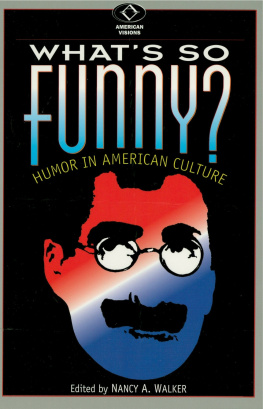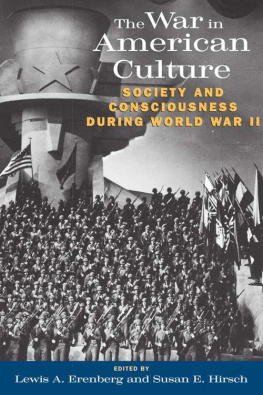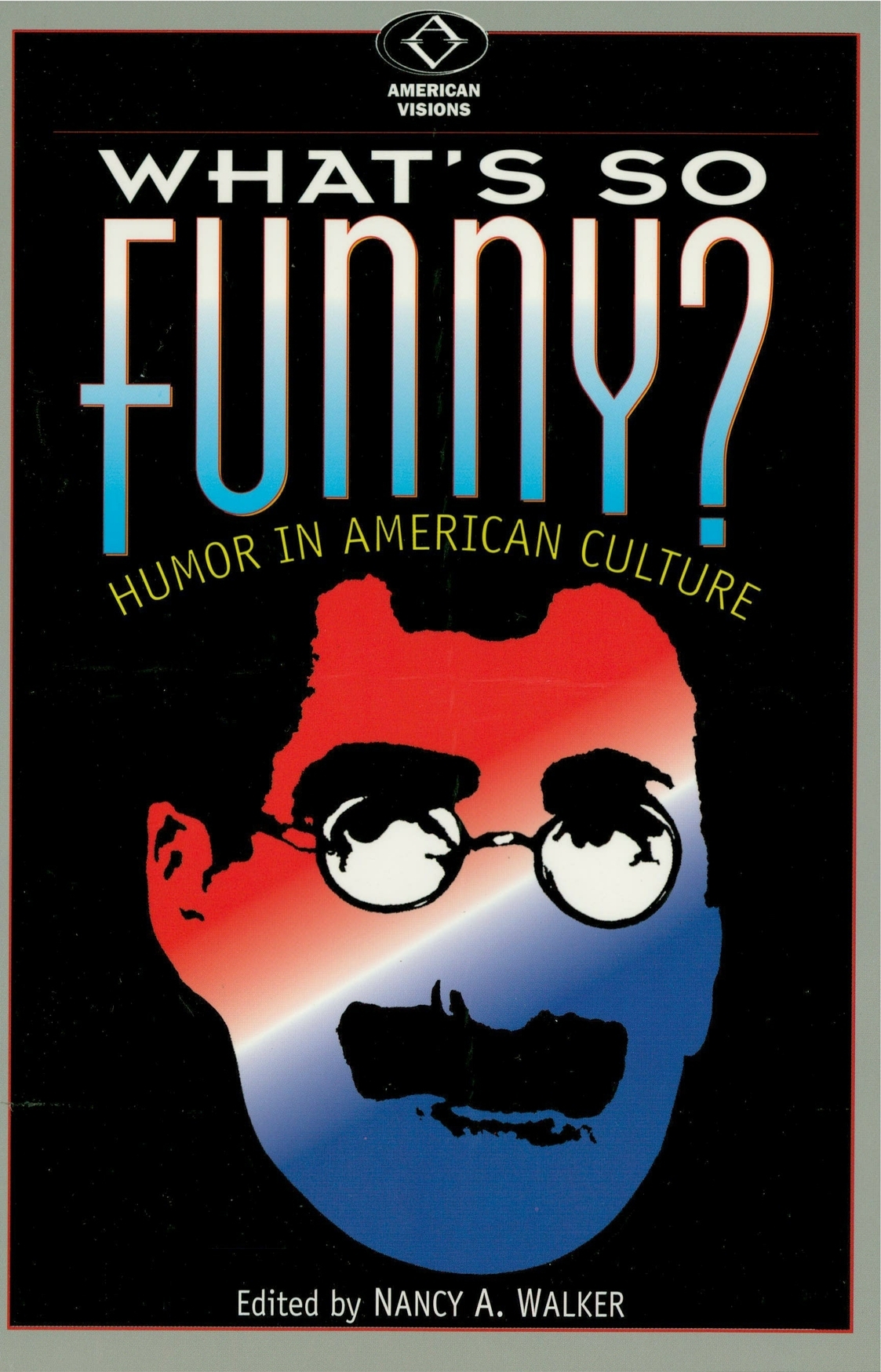NANCY A. WALKER
Introduction
What Is Humor? Why American Humor?
We begin with a paradox: humorthat is, the ability to smile and laugh, and to make others do sois a nearly universal human trait, and yet most people who attempt to write about humor acknowledge that it is difficult to define, grasp, and pin down. Why should this be the case? Why should something so common be at the same time so elusive? Most of us claim to have a sense of humor, yet we would be hard-pressed to say just what that sense is. Because this volume is a collection of essays about the humorous expressions of America as a nation, essays which in some way do attempt to define that humor, we should first consider why the study of humor presents such challenges.
Humor takes many forms, ranging from the casual level of the joke told to friends to the sophistication of a Shakespearean comedy. Some humor, such as a slapstick routine or a pun, is intended primarily for amusement, while such forms as political satire have quite serious purposes; for well over a hundred years, political cartoons in daily newspapers have attempted to influence public opinion on important issues. Humor may take the form of what is called light verse, such as the writings by Ogden Nash and Phyllis McGinley, or it may be an element in what we consider serious literature, such as the novels of Mark Twain and William Faulkner. In fact, many writers use humor to call the readers attention to a serious message. Dorothy Parker, for example, although known as a humorist associated with The New Yorker magazine and the Algonquin Round Table in the early decades of the twentieth century, used the medium of light verse to convey biting commentary on relationships between men and women, as in her Unfortunate Coincidence:
By the time you swear youre his,
Shivering and sighing,
And he vows his passion is
Infinite, undying
Lady, make a note of this:
One of you is lying.
Humor may, then, be written or spoken; it may take the form of song lyrics, physical clowning, or the comic strip.
This diversity, in turn, suggests that in addition to its many forms, humor appears in numerous mediaespecially in the late twentieth century. Whereas in colonial New England most people experienced humor in the form of spoken and written jokes, political satire, and comic songs, today there are television situation comedies and stand-up comics, comedic films, and humorous pieces circulating on the Internet. The comic strip, an American invention that observed its hundredth anniversary in 1995, is a feature of virtually every newspaper, and comedy clubs bring comedians and audiences face-to-face in cities throughout America. And just as developments in technology have changed the ways in which we experience humor (the seventeenth-century colonists had the printing press; we have electronic media), so American humor has changed over time. Humor, like all forms of communication, requires context : to find it amusing, the audience must have certain knowledge, understanding, and values, which are subject to evolution from one century or even one decade to the next. For example, readers today probably would not find much humor in a political satire related to obscure events of two hundred years ago, nor would most of us be much amused by a pun in the Elizabethan English of the seventeenth century. While racist humor has certainly not disappeared, the minstrel show, featuring white actors in blackface and turning upon the stereotype of the African American as childlike and gullible, is a thing of the past. Since humor often depends upon the context of a particular time, topical humor seldom lasts past its own day. In his introduction to A Subtreasury of American Humor, published in 1941, E. B. White notes that he and his coeditor, Katharine White, had originally intended to include newspaper humor, but found that it became stale with age: Even the perfect newspaper story, by the most expert and gifted reporter, dies like a snake with the setting of the sun.
Another dimension of the challenges involved in defining and analyzing humor is that there are many purposes for and methods of doing so. Those who study humor are usually not interested in explaining why something is funny, for reasons that E. B. White also expressed in the Subtreasury : Humor can be dissected, as a frog can, but the thing dies in the process and the innards are discouraging to any but the pure scientific mind (xvii). Sociologists commonly study how humor works in social settingsthe relationship between humor and such matters as social class, power relationships, and gender differences. Psychologists, on the other hand, have been inclined to look at humor as a manifestation of human mental and emotional development. How, they ask, do people use and respond to humor at different stages of the life cycle and in different psychological states? What is the usefulness of humor to the human psyche? Sigmund Freud, who is often credited with helping the field of psychology achieve mature status, was extremely interested in humor, especially in joking behavior. For Freud, humor functioned as a sort of release from the rule-bound superego that he believed regulated human social behavior. In his 1927 essay, Humor, Freud termed humor liberating, a release from reality. More recently, a number of medical professionals have investigated the function of humor in the processes of healing and recovery; they are interested in the function of humor, but in a physical rather than a psychological sense.
Students of American culture are likely to ask an entirely different set of questions about humor than do those who are concerned with what effects it has on either groups or individuals. Reduced to its simplest level, the difference might be stated as follows: rather than asking what does humor do ? they ask what kinds of humor have Americans created? Why? What can humor tell us about American values, experience, and aspirations? Put a different way, the study of humor becomes yet another way of understanding social history, cultural institutions, and the development of both a sense of national identity and threats to that identity. To use again the minstrel show as an example: students of American culture are interested in what this form of humorous expression can tell us about race relations in the nineteenth century and how elements of such performances were later carried over into the vaudeville theater and into popular radio programs such as Amos n Andy in the 1930s. Similarly, a study of the witty but world-weary verse of a writer such as Dorothy Parker can provide insight into changes in literary taste as America became a more urban than rural country by the 1920s, when magazines such as The New Yorker (founded in 1925) helped to define a kind of city sophistication that was in sharp contrast to the boisterous frontier humor that had flourished in the nineteenth century.
Another consideration in the study of humor is the extent to which we should take it seriously. In the field of literature in particular, scholars have tended to value tragedy over comedy, viewing the comic as a form that has less to tell us about the important moments of human experience. E. B. White also addresses this point in introducing the Subtreasury : The world likes humor, but treats it patronizingly. It decorates its serious artists with laurel, and its wags with Brussels sprouts. It feels that if a thing is funny it can be presumed to be something less than great, because if it were truly great it would be wholly serious (xviii). White goes on to point out that because writers themselves are well aware of this distinction, a number of them have signed their real names to their serious work and used pseudonyms when they wrote humor. And yet when we consider some of the classic works in the American literary tradition, we cannot say that they are wholly serious. Mark Twains novel The Adventures of Huckleberry Finn, for example, achieves much of its effect through Twains use of many of the major techniques of humor, including slapstick, satire, mistaken identity, wordplay, and exaggeration. While it can certainly be argued that identifying comic elements in a novel about slavery is a different matter than assessing the value of a comic strip or a television situation comedy, it is nonetheless true that many of Americas prominent writers have found the various techniques of humor quite congenial to their purposes, including authors as otherwise different as Herman Melville, Henry James, Gertrude Stein, and Eudora Welty.







![David Schmid (editor) - Violence in American Popular Culture [2 volumes]](/uploads/posts/book/262757/thumbs/david-schmid-editor-violence-in-american.jpg)


